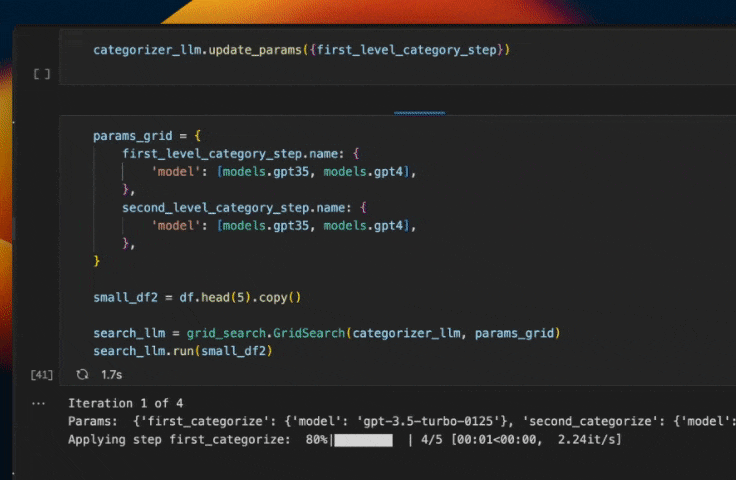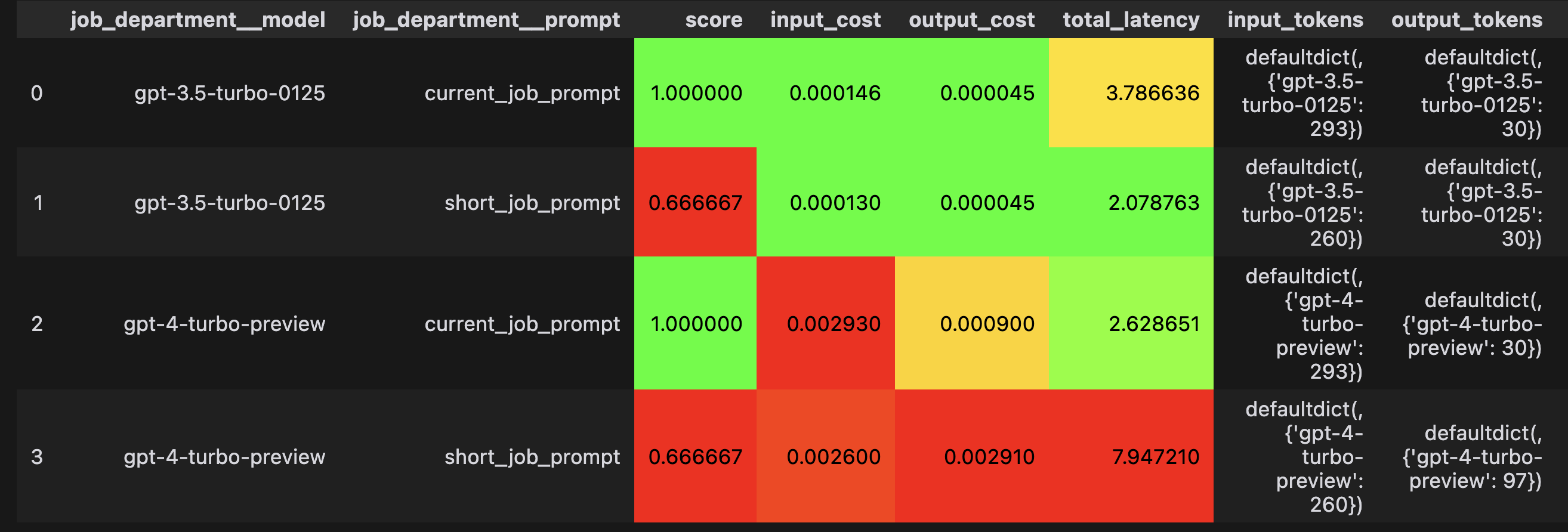Superpipe - optimized LLM pipelines for structured data¶
A lightweight framework to build, evaluate and optimize LLM pipelines for structured outputs: data labeling, extraction, classification, and tagging. Evaluate pipelines on your own data and optimize models, prompts and other parameters for the best accuracy, cost, and speed.

Installation¶
Make sure you have Python 3.10+ installed, then run
Build, evaluate, optimize¶
There are three stages of using Superpipe.
- Build — use your favorite LLM library (langchain, LlamaIndex) and combine with Superpipe's building blocks.
- Evaluate — your pipeline needs to be evaluated on your data. Your data and use case are unique, so benchmarks are insufficient.
- Optimize — build once, experiment many times. Easily try different models, prompts, and parameters to optimize end-to-end.
To see a toy example, keep reading. For more details go to Step 1: Build
Build¶
In this toy example, we'll use Superpipe to classify someone's work history into job departments. A superpipe pipeline consists of one or more steps. Each step takes in an input dataframe or dictionary and returns a new dataframe or dictionary with the outputs of the step appended.
Below, we use a built-in Superpipe step: LLMStructuredStep which extracts structured data using an LLM call. The expected structure is specified by a Pydantic model.
from superpipe.steps import LLMStructuredStep
from superpipe.models import gpt35
from pydantic import BaseModel, Field
work_history = "Software engineer at Tech Innovations, project manager at Creative Solutions, CTO at Startup Dreams."
input = {"work_history": work_history}
def current_job_prompt(row):
return f"""Given an employees work history, classify them into one of the following departments:
HR, Legal, Finance, Sales, Product, Founder, Engineering
{row['work_history']}"""
class Department(BaseModel):
job_department: str = Field(description="Job department")
job_department_step = LLMStructuredStep(
model=gpt35,
prompt=current_job_prompt,
out_schema=Department,
name="job_department")
job_department_step.run(input)
Show output
In addition to the input (work_history) and result (job_department), the output also contains some step metadata for the job_department step including token usage, cost, and latency.
{
"work_history": "Software engineer at Tech Innovations, project manager at Creative Solutions, CTO at Startup Dreams.",
"__job_department__": {
"input_tokens": 97,
"output_tokens": 10,
"input_cost": 0.0000485,
"output_cost": 0.000015,
"success": true,
"error": null,
"latency": 0.9502187501639128,
"content": {
"job_department": "Engineering"
}
},
"job_department": "Engineering"
}
Evaluate¶
Once you've built your pipeline it's time to see how well it works. Think of this as unit tests for your code. You wouldn't ship code to production without testing it, you shouldn't ship LLM pipelines to production without evaluating them.
This requires:
- A dataset with labels - the correct label for each row in your data. You can use an early version of your pipeline to generate candidate labels and manually inspect and correct to generate your ground truth.
- Evaluation function - a function that defines what "correct" is. In this example we use a simple string comparison evaluation function, but in general it could be any arbitrary function, including a call to an LLM to do more advanced evals.
from superpipe.pipeline import Pipeline
import pandas as pd
work_histories = [
"Software engineer at Tech Innovations, project manager at Creative Solutions, CTO at Startup Dreams.",
"Journalist for The Daily News, senior writer at Insight Magazine, currently Investor at VC Global.",
"Sales associate at Retail Giant, sales manager at Boutique Chain, now regional sales director at Luxury Brands Inc."
]
labels = [
"Engineering",
"Finance",
"Sales"
]
input = pd.DataFrame([{"work_history": work_histories[i], "label": labels[i]} for i in range(3)])
evaluate = lambda row: row["job_department"] == row["label"]
categorizer = Pipeline(
steps=[job_department_step],
evaluation_fn=evaluate)
categorizer.run(input)
print(categorizer.statistics)
Show output
The score field is calculated by applying the evaluate function on each row. In this case we were able to correctly classify each row so the score is 1 (i.e. 100%). We can also see the total cost and latency.
+---------------+------------------------------+
| score | 1.0 |
+---------------+------------------------------+
| input_tokens | {'gpt-3.5-turbo-0125': 1252} |
+---------------+------------------------------+
| output_tokens | {'gpt-3.5-turbo-0125': 130} |
+---------------+------------------------------+
| input_cost | $0.0006259999999999999 |
+---------------+------------------------------+
| output_cost | $0.00019500000000000005 |
+---------------+------------------------------+
| num_success | 3 |
+---------------+------------------------------+
| num_failure | 0 |
+---------------+------------------------------+
| total_latency | 9.609524499624968 |
+---------------+------------------------------+
Optimize¶
The last step in using Superpipe is trying out many combinations of parameters to optimize your pipeline along cost, accuracy, and speed. In this example, we'll try two different models and two prompts (4 combinations). Superpipe's grid search makes it easy to try all combinations - build once, experiment many times.
from superpipe.grid_search import GridSearch
from superpipe.models import gpt35, gpt4
def short_job_prompt(row):
return f"""Classify into: HR, Legal, Finance, Sales, Product, Founder, Engineering
{row['work_history']}"""
params_grid = {
job_department_step.name: {
"model": [gpt35, gpt4],
"prompt": [current_job_prompt, short_job_prompt]
},
}
grid_search = GridSearch(categorizer, params_grid)
grid_search.run(input)
Show output
The results of the grid search show that:
- The longer prompt is more accurate even though it costs more and is slower
- There's no advantage in using gpt4 instead of gpt3.5

Next Steps¶
Step 1: Build — to get started building with Superpipe.
Concepts — to understand the core concepts behind Superpipe.
Why Superpipe? — to understand whether Superpipe is right for you.
Examples — for more advanced examples and usage.